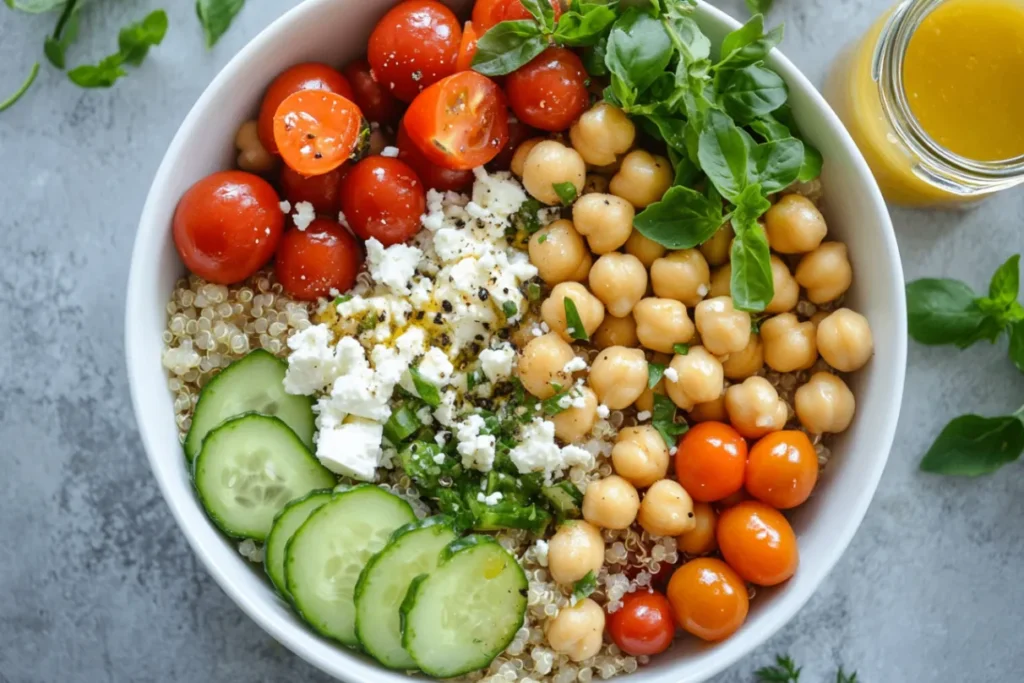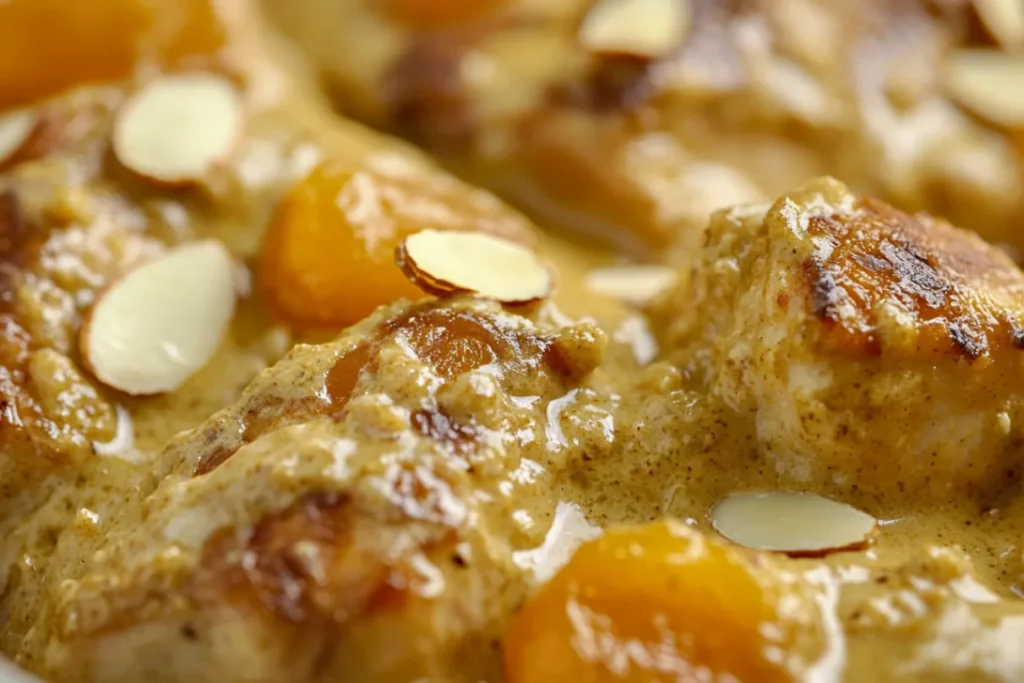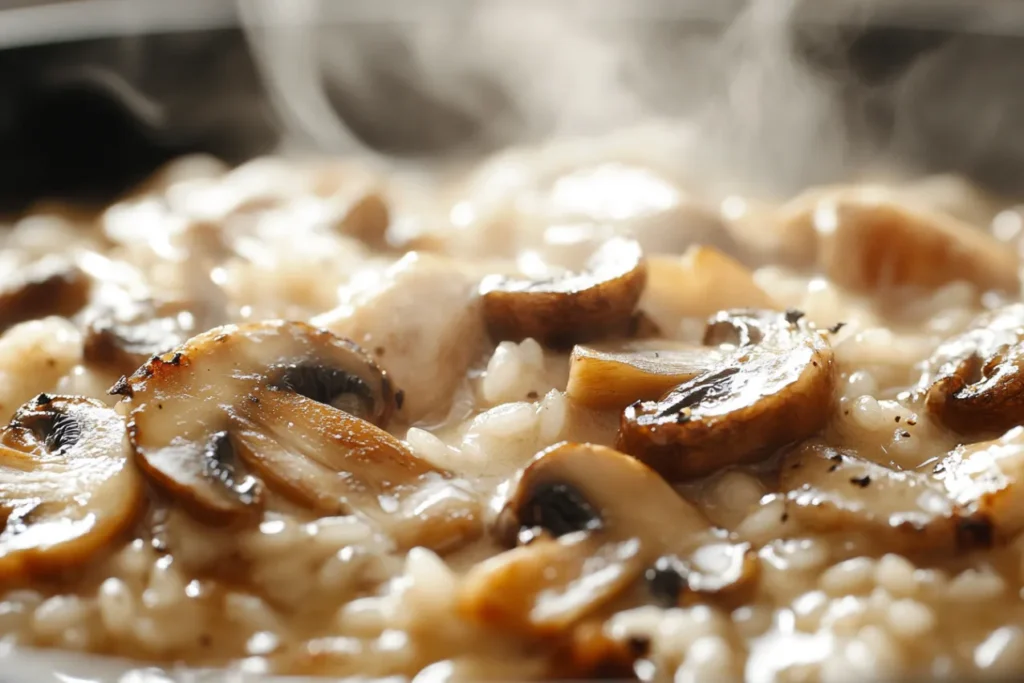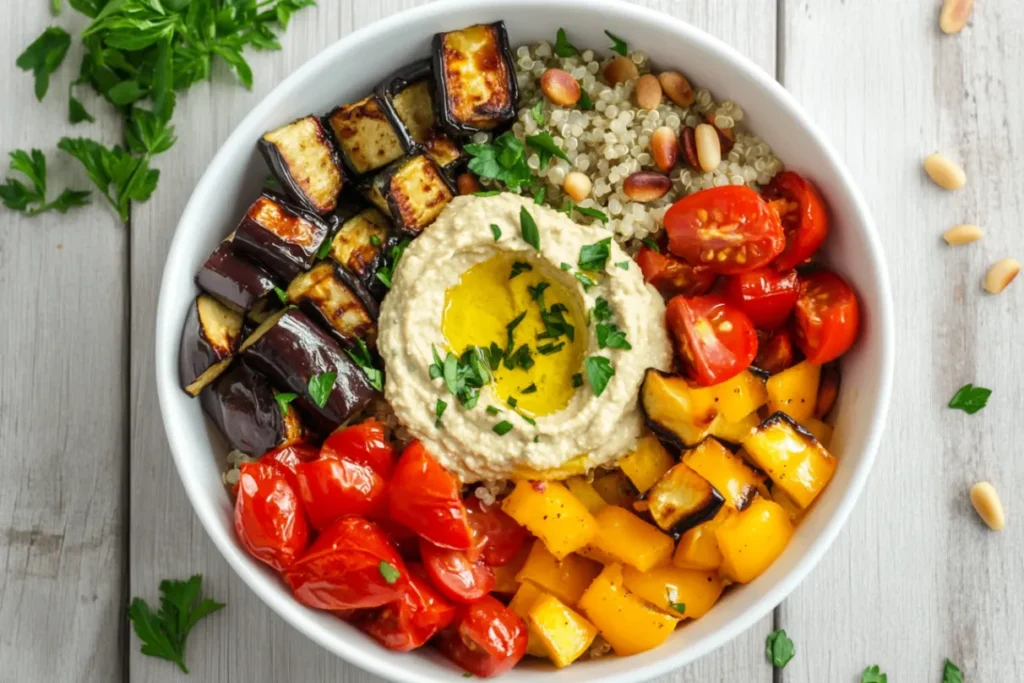
Introduction
There’s something magical about a perfectly balanced Mediterranean grain bowl that transports you straight to the sun-soaked shores of the Mediterranean Sea. I’m Jowel, and I have to tell you, this Mediterranean grain bowl with roasted veggies and hummus has become my absolute go-to recipe when I want something that’s both incredibly satisfying and surprisingly easy to make.
I’ll never forget the first time I discovered the beauty of grain bowls during a trip to a small coastal town in Greece. I was sitting at a tiny taverna overlooking the azure waters, and the owner brought me this incredible bowl filled with perfectly seasoned grains, the most vibrant roasted vegetables I’d ever seen, and a dollop of hummus so creamy it made me question everything I thought I knew about chickpea spreads. That moment changed my perspective on easy homemade recipes forever.
What makes this Mediterranean grain bowl so special isn’t just its incredible flavor – though trust me, we’ll get to that – it’s how it brings together the essence of Mediterranean cooking in one beautiful, nutritious bowl. This recipe has become one of my family favorite recipes because it’s versatile enough to please everyone while being packed with wholesome ingredients that make you feel good from the inside out.
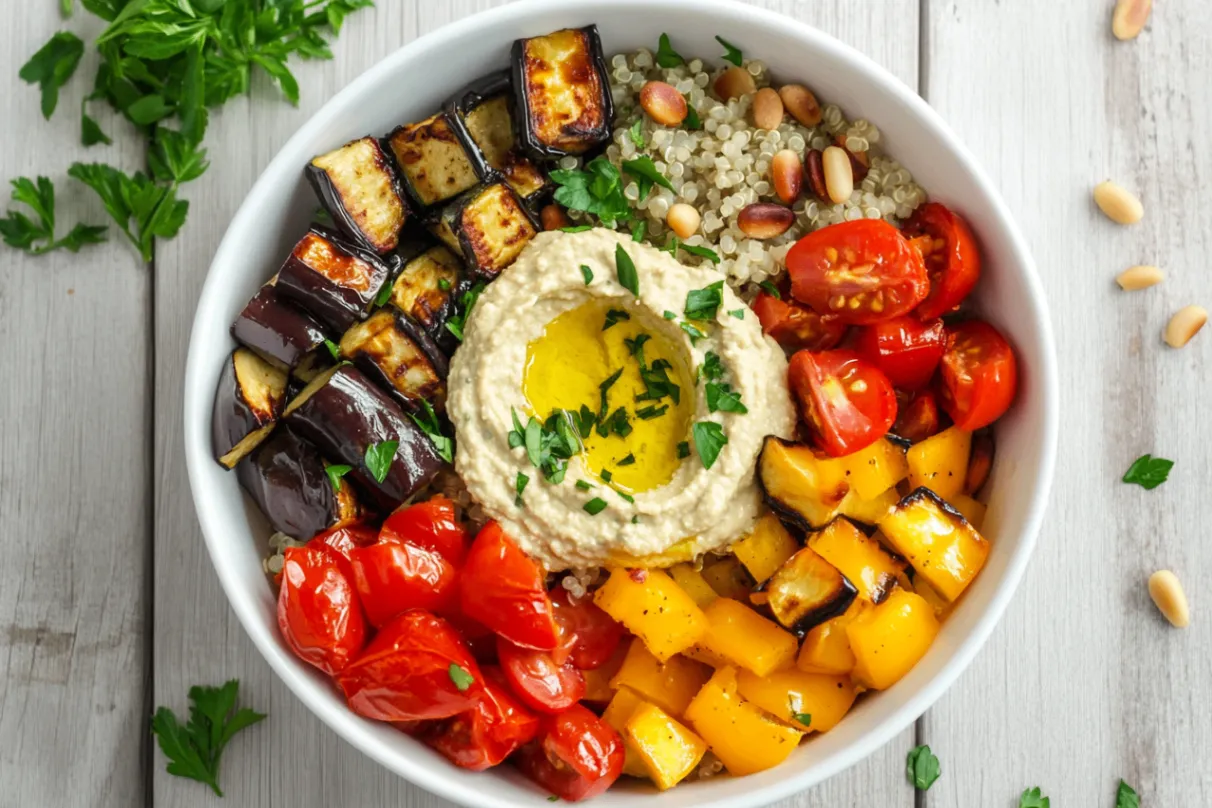
Mediterranean Grain Bowl with Roasted Veggies and Hummus
A vibrant and nutritious Mediterranean grain bowl featuring perfectly roasted vegetables, fluffy quinoa and bulgur wheat, and creamy homemade hummus. This easy homemade recipe brings together the best flavors of Mediterranean cuisine in one satisfying bowl.
Ingredients
Instructions
- 1Rinse quinoa and bulgur wheat until water runs clear. Cook in vegetable broth according to package directions. Fluff with fork and season with olive oil, lemon juice, salt, and pepper.
- 2Preheat oven to 425°F. Cut zucchini and eggplant into 1-inch cubes, slice bell peppers, quarter red onion. Salt eggplant and let sit 15 minutes, then pat dry.
- 3Toss eggplant and onion with olive oil, salt, pepper, and thyme. Roast 15 minutes. Add zucchini and peppers, roast 10-15 minutes. Add cherry tomatoes for final 8-10 minutes until all vegetables are tender and caramelized.
- 4Divide grains among 4 bowls. Top with roasted vegetables in colorful sections. Add a dollop of hummus in center. Drizzle with olive oil and garnish with fresh herbs, pine nuts, and olives.
Understanding the Heart of Your Mediterranean Grain Bowl: Essential Ingredients
The Foundation: Grains That Make All the Difference
The star of any great Mediterranean grain bowl is, naturally, the grain itself. While quinoa has become incredibly popular, I’ve found that a mixture of quinoa and bulgur wheat creates the most authentic Mediterranean flavor profile. The quinoa provides that light, fluffy texture with a subtle nutty taste, while bulgur adds a heartier, more substantial bite that really makes this dish feel like a complete meal.
For this recipe, you’ll need about 1 cup of quinoa and ½ cup of bulgur wheat. The beauty of these grains lies in their ability to absorb flavors beautifully while maintaining their individual textures. I always cook my grains in vegetable broth instead of water – this simple swap elevates the entire dish and gives it that rich, savory base that makes every bite sing with flavor.
Brown rice also works wonderfully if you can’t find bulgur, and farro is another excellent option that adds a delightfully chewy texture. The key is choosing grains that can stand up to the bold Mediterranean flavors without getting lost in the mix.
Selecting the Perfect Vegetables for Roasting
The roasted vegetables are truly where this Mediterranean grain bowl shines, and choosing the right ones can make or break your dish. My go-to combination includes zucchini, bell peppers (red and yellow for the most vibrant colors), red onion, cherry tomatoes, and eggplant. Each vegetable brings something unique to the table – the zucchini becomes tender and slightly caramelized, the peppers add sweetness and crunch, the red onion provides a sharp contrast that mellows beautifully when roasted, and the eggplant becomes creamy and rich.
When selecting your vegetables, look for ones that are firm and vibrant in color. The cherry tomatoes should be plump but not soft, the zucchini should feel heavy for their size without any soft spots, and the bell peppers should have smooth, glossy skin. The eggplant should feel firm and the skin should be taut and shiny.
Don’t forget about the herbs and aromatics that will infuse your vegetables with that unmistakable Mediterranean flavor. Fresh rosemary, thyme, and oregano are essential, along with plenty of good quality olive oil, minced garlic, and a sprinkle of sea salt and freshly cracked black pepper.

The Hummus: Store-Bought vs. Homemade Magic
While you can certainly use store-bought hummus, making your own transforms this Mediterranean grain bowl from good to absolutely extraordinary. The difference is night and day, and once you taste homemade hummus, you’ll understand why it’s worth the extra effort.
For the creamiest, most flavorful hummus, you’ll need chickpeas (I prefer using dried chickpeas that I cook myself, but high-quality canned ones work in a pinch), tahini, fresh lemon juice, garlic, olive oil, and a touch of cumin. The secret to restaurant-quality hummus is removing the skins from the chickpeas – it takes a few extra minutes, but the silky smooth texture is absolutely worth it.
If you’re short on time, look for hummus brands that use minimal ingredients and avoid those with unnecessary preservatives. The best store-bought options will list chickpeas, tahini, lemon juice, olive oil, and garlic as their primary ingredients, just like you’d use at home.
Mastering the Art of Preparation: From Prep to Plate
Setting Up for Success: Prep Work That Makes Everything Easier
The key to creating delicious dishes like this Mediterranean grain bowl without stress is proper preparation. I always start by washing and chopping all my vegetables first. Cut the zucchini and eggplant into roughly 1-inch cubes, slice the bell peppers into strips, quarter the red onion, and leave the cherry tomatoes whole but give them a gentle rinse.
Here’s a pro tip that took me years to learn: after cutting the eggplant, sprinkle it with salt and let it sit for about 15 minutes. This draws out any bitterness and helps it roast more evenly. While the eggplant is sitting, rinse your grains thoroughly until the water runs clear – this removes excess starch and prevents your grains from becoming gummy.
Preheat your oven to 425°F (220°C) and line a large baking sheet with parchment paper. If you’re making homemade hummus, this is also the perfect time to start soaking your chickpeas if you’re using dried ones, or to begin the hummus-making process if you’re using canned chickpeas.
The Roasting Process: Where the Magic Happens
Roasting vegetables for your Mediterranean grain bowl is an art form that requires attention to timing and technique. Not all vegetables cook at the same rate, so I’ve developed a system that ensures everything finishes perfectly at the same time.
Start by tossing your eggplant and red onion with olive oil, salt, pepper, and fresh thyme – these take the longest to cook. Spread them on your prepared baking sheet and roast for about 15 minutes. Then add the zucchini and bell peppers, tossing everything together with a bit more olive oil and some minced garlic. Roast for another 10-15 minutes before adding the cherry tomatoes for the final 8-10 minutes.
The vegetables should be tender and slightly caramelized, with some beautiful golden-brown edges. If they’re browning too quickly, lower the oven temperature to 400°F. If they seem to be taking too long, increase it to 450°F. Every oven is different, so trust your eyes and nose – you’ll know they’re ready when they smell incredible and look golden and tender.
While the vegetables are roasting, cook your grains according to package directions, but use vegetable broth instead of water for maximum flavor. Once cooked, fluff them with a fork and let them cool slightly.
Avoiding Common Pitfalls: Lessons Learned the Hard Way
Over the years of perfecting this Mediterranean grain bowl recipe, I’ve made every mistake in the book so you don’t have to. The most common error I see people make is overcrowding the vegetables on the baking sheet. When vegetables are too close together, they steam instead of roast, resulting in soggy, lackluster vegetables instead of the beautiful caramelized ones we’re after.
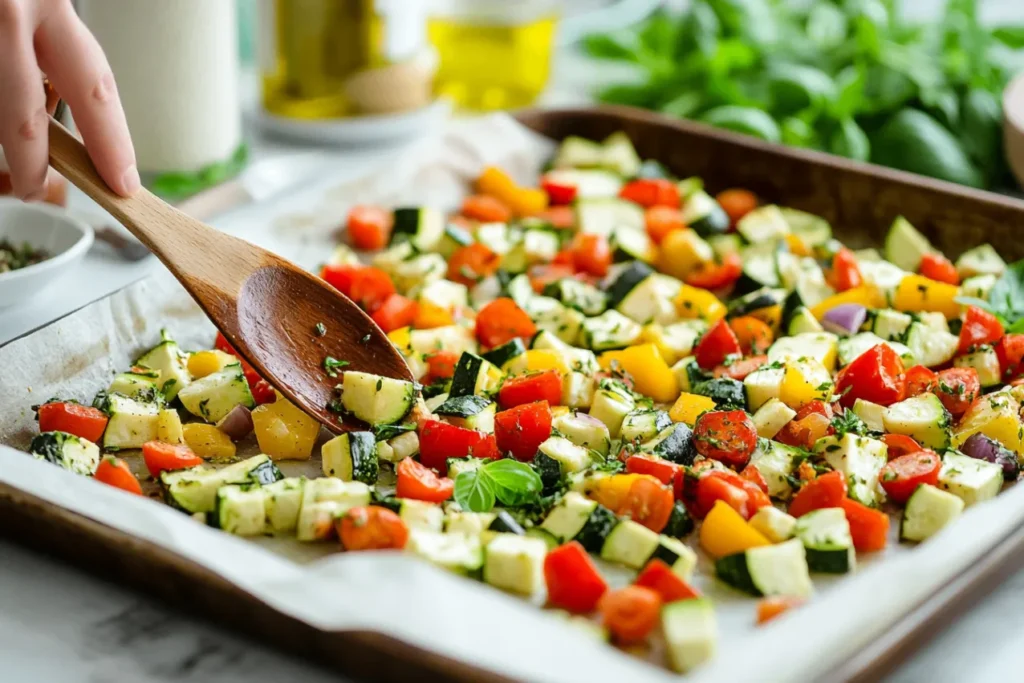
Another mistake is not seasoning the grains properly. Plain grains, even when cooked in broth, can taste bland next to all those flavorful roasted vegetables. After cooking your grains, toss them with a drizzle of good olive oil, a squeeze of fresh lemon juice, and a pinch of salt and pepper.
Temperature is crucial too – if your oven isn’t hot enough, the vegetables will take forever to cook and may never develop that beautiful caramelization we’re looking for. If it’s too hot, they’ll burn on the outside before cooking through. That sweet spot around 425°F gives you the perfect balance of caramelization and even cooking.
Bringing It All Together: Serving and Savoring Your Creation
Presentation That Wow: Making Your Bowl Instagram-Worthy
The beauty of a Mediterranean grain bowl lies not just in its taste, but in its visual appeal. Start with a wide, shallow bowl – this gives you the perfect canvas to create an Instagram-worthy presentation. Spread your seasoned grains as the base, creating a small well in the center where you’ll place a generous dollop of hummus.
Arrange your roasted vegetables around the bowl in colorful sections – this creates visual interest and makes each component stand out. I like to group similar colors together and then contrast them with different textures. For example, place the golden bell peppers next to the deep purple eggplant, and contrast the round cherry tomatoes with the linear zucchini pieces.
Finish with a drizzle of your best olive oil, a sprinkle of fresh herbs (parsley and mint work beautifully), a handful of toasted pine nuts or pumpkin seeds for crunch, and perhaps a few Kalamata olives for that authentic Mediterranean touch. A final squeeze of fresh lemon juice over the entire bowl brightens everything up and ties all the flavors together.
Perfect Pairings: What to Serve Alongside Your Mediterranean Bowl
While this Mediterranean grain bowl is absolutely satisfying on its own, there are some perfect pairings that can turn it into a complete Mediterranean feast. A simple Greek salad with cucumber, tomatoes, red onion, and feta cheese provides a refreshing contrast to the warm, hearty grain bowl.
For bread lovers, warm pita bread or focaccia is perfect for scooping up any extra hummus or collecting those delicious roasted vegetable pieces. If you want to add some protein, grilled chicken seasoned with Mediterranean herbs, or some crumbled feta cheese work beautifully without overwhelming the dish.
A glass of crisp white wine like Sauvignon Blanc or a light red like Pinot Noir complements the Mediterranean flavors perfectly. For non-alcoholic options, try sparkling water with lemon and mint, or a refreshing iced herbal tea.
Storage and Reheating: Making Your Meal Prep Dreams Come True
One of the things I love most about this Mediterranean grain bowl is how well it works for meal prep. You can prepare all the components ahead of time and store them separately for the freshest results. The roasted vegetables keep in the refrigerator for up to 4 days and actually taste even better the next day as the flavors continue to develop.
The grains can be stored separately for up to 5 days and are delicious both cold and reheated. If you’re reheating, add a splash of broth or water to prevent them from drying out. The homemade hummus will keep for up to a week in the refrigerator – just give it a good stir before serving as it may separate slightly.
 DINNER
DINNER LUNCH
LUNCH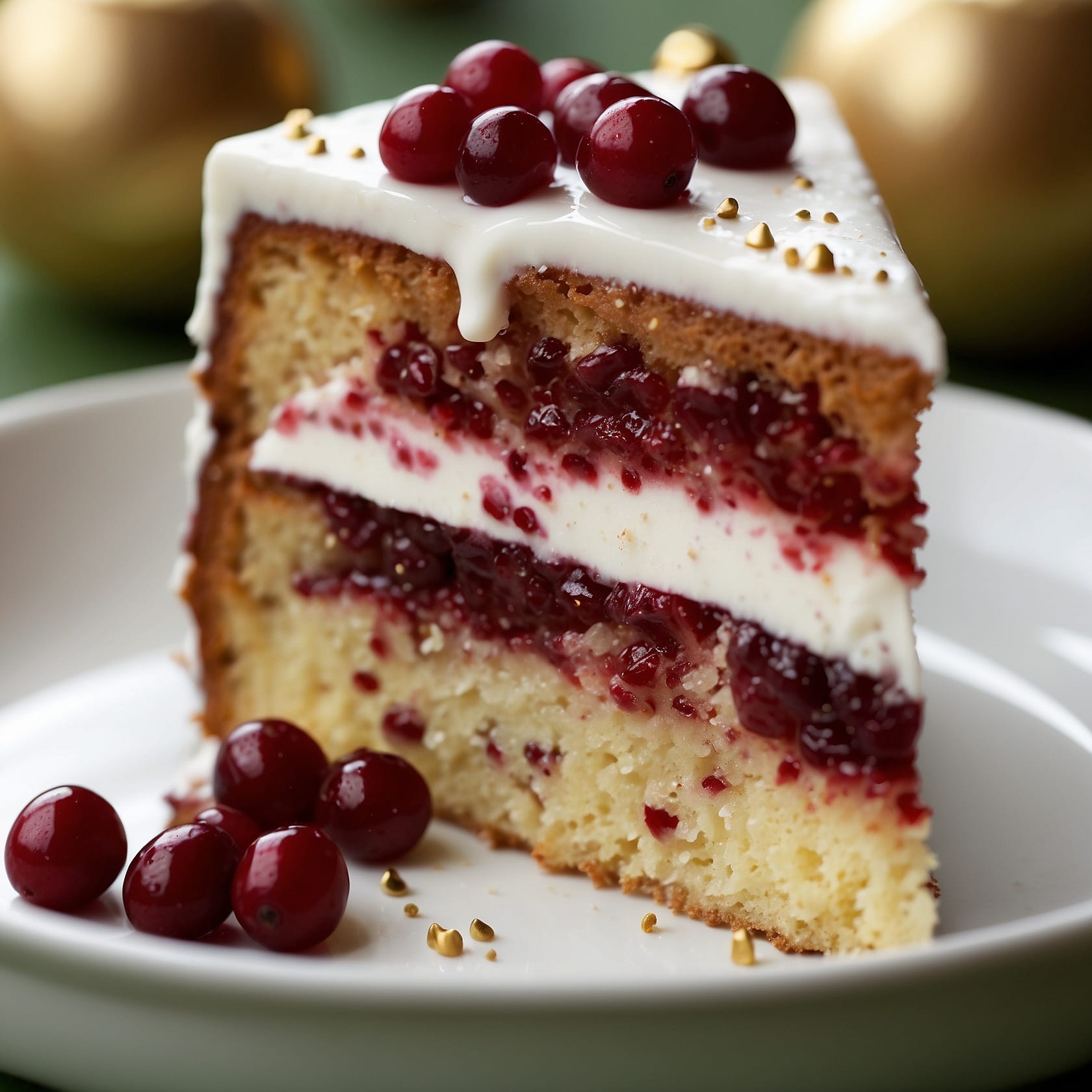 CAKE
CAKE BREAKFAST
BREAKFASTFor more amazing recipes, be sure to check out our other sections to explore a variety of ideas that will enrich your cooking experience. Each section offers its own unique flavors to ensure a delightful culinary journey:
- Easy and Quick Recipes: A collection of dishes that guarantee delicious meals with minimal effort and time.
- Healthy Recipes: Discover healthy and delicious options that fit your lifestyle.
- Desserts: A diverse selection of sweets that will add a special touch of sweetness to your table.
- Lunch Recipes: Tasty lunch ideas that you can easily prepare to delight your family.
- Dinner Recipes: Delicious and easy-to-make recipes that will make your dinner a memorable occasion.
For the best results, assemble your bowls fresh when you’re ready to eat. If you must assemble them ahead of time, keep the hummus and any fresh herbs separate until serving to maintain the best textures and flavors.
Frequently Asked Questions
Q: Can I make this Mediterranean grain bowl vegan? A: Absolutely! This recipe is naturally vegan as written. Just make sure your hummus doesn’t contain any dairy products (most traditional hummus recipes are vegan) and use vegetable broth for cooking the grains. You can add extra protein with chickpeas, hemp seeds, or tahini drizzle.
Q: How long does it take to make this entire Mediterranean grain bowl from start to finish? A: From start to finish, this recipe takes about 45 minutes to an hour. The grains take about 15-20 minutes to cook, while the vegetables roast for 35-40 minutes. If you’re making homemade hummus, add an additional 10-15 minutes. You can multitask by cooking the grains while the vegetables roast to save time.
Q: Can I substitute the quinoa and bulgur with other grains? A: Definitely! Brown rice, farro, wild rice, or even cauliflower rice work wonderfully. Each grain will bring its own unique texture and flavor. Cooking times may vary, so adjust accordingly. For a gluten-free option, stick with quinoa, brown rice, or wild rice.
Q: What’s the best way to reheat leftover roasted vegetables? A: The best method is to reheat them in a 350°F oven for 8-10 minutes until warmed through. This helps maintain their texture better than microwaving. You can also quickly sauté them in a pan with a drizzle of olive oil for 3-4 minutes.
Q: How can I add more protein to make this more filling? A: There are many ways to boost the protein content! Try adding grilled chicken, lamb, or fish. For vegetarian options, consider adding crumbled feta cheese, hard-boiled eggs, roasted chickpeas, or a sprinkle of hemp seeds. Each option complements the Mediterranean flavors beautifully.
Your Culinary Adventure Awaits
Creating this Mediterranean grain bowl with roasted veggies and hummus isn’t just about following a recipe – it’s about embarking on a culinary journey that connects you to the time-honored traditions of Mediterranean cooking. Every time I make this dish, I’m reminded of that magical moment in Greece when I first discovered how simple ingredients, treated with respect and prepared with love, can create something truly extraordinary.
The beauty of this recipe lies in its flexibility and forgiving nature. Don’t have eggplant? Substitute with roasted cauliflower. Prefer farro over bulgur? Go for it! The key is to embrace the spirit of Mediterranean cooking: fresh ingredients, bold flavors, and the joy of sharing good food with people you care about.
I encourage you to make this recipe your own. Try different vegetable combinations, experiment with various grains, and don’t be afraid to adjust the seasonings to suit your taste. Each time you make it, you’ll discover something new and delicious.
Please don’t keep this amazing Mediterranean grain bowl to yourself – share it with friends and family, and let me know how your version turned out! I love hearing about the creative variations and personal touches that home cooks add to make these recipes truly their own.

